The Great 1080p HDTV Face Off Sony KDS-R50XBR1
Balance.
Going into the Face Off, I had no idea which display would win. In hindsight, I could have guessed. I reviewed this set's big brother in the December 2005 issue and thought it was the RPTV to beat. It turns out that is the case. Jerry ranked this set fourth, Maureen second, and everyone else number one.
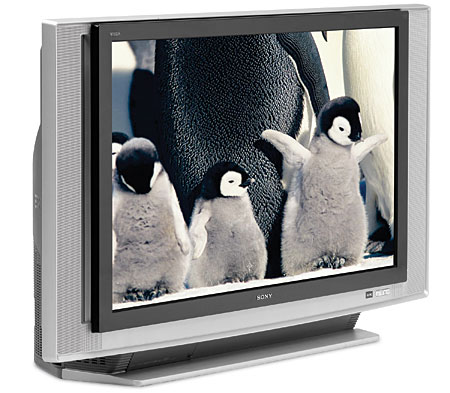
From the measurement point of view, the Sony is average or just above average in every category. It was just a tick above the Samsung and the Mitsubishi in total light output, its only category win. While other TVs were brighter (the JVC being a notable one), none were able to be that bright while continuing to have such a strong contrast ratio. Adrienne liked that, with its many iris adjustments, the Sony was more flexible than the others in the Face Off. With its main iris closed down, the KDS-R50XBR1 was capable of 0.017 ft-L, just behind the HP and the Toshiba in its darkest mode. During the Face Off, though, the black level and contrast ratio got lukewarm praise, with Jerry commenting that it seemed "a bit washed out compared with some of the others." This could be because it had the second lowest ANSI contrast ratio, something no amount of iris manipulation can help.
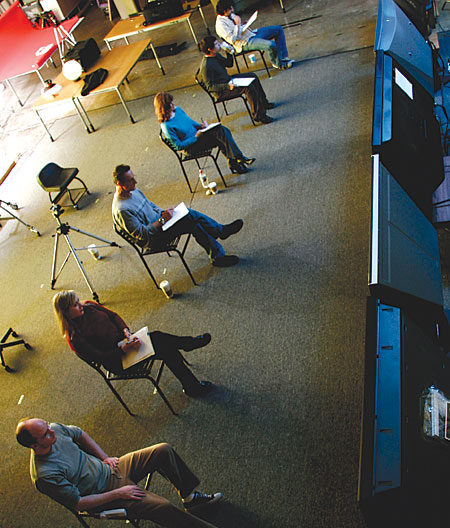
The Sony's color, like with the 60-inch model I reviewed last December, was a mixed bag. The color points are still off, but color temperature out of the box and after calibration are both decent. John felt that the colors were "a little rich, almost too rich," Maureen called it "a bit overcolorful," and Nikhil thought it was "very electric, almost cartioonish."  Seeing as I found the same problem with the 60-inch model, it seems that's just what Sony wants in this set: uber-vibrant. No reviewer found it to be too objectionable, although no one called it accurate or neutral.
Seeing as I found the same problem with the 60-inch model, it seems that's just what Sony wants in this set: uber-vibrant. No reviewer found it to be too objectionable, although no one called it accurate or neutral.
Our judges praised the Sony's detail, too, although they felt that some of the other displays were more detailed. Most of the judges felt that the Sony was a little noisy with 480i, especially with dark areas of the scene. Otherwise, each reviewer felt that there was less noise and grain in the image than with most of the sets in the Face Off (trailing the JVC). The image processing was only OK, with fairly slow 3:2 pickup and some jagged edges on the waving flag.
Maureen liked the stylish remote, but Adrienne felt that it was too heavy and didn't like the lack of (wait for it) direct input-access buttons (see a trend here?).
Adrienne summed it up the best by calling the KDS-R50XBR1 a "consistently good performer." From how close this Face Off was, it's not a shock that consistency was the key over excelling in one area and messing up another. That kind of balance will win you Face Offs all the time.
Highlights
• Widely adjustable iris
• An excellent balance of everything
At A Glance: Sony KDS-R50XBR1 Rear-Projection HDTV
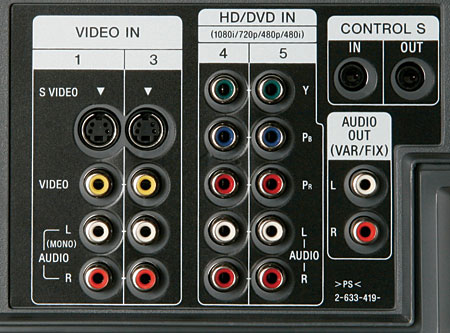
Connections
Inputs:
Video: HDMI (2), RGB D-Sub-15 (1), component video (2), S-video (3), composite video (3)
Audio: analog stereo (7)
Outputs:
Video: none
Audio: Optical (1), analog audio (1)
Additional: RF (2), FireWire (2), CableCARD (1), Control-S (2)
Features
Type: LCOS (SXRD)
Screen Size (diagonal): 50 inches
Native Resolution: 1,920 by 1,080 Lamp Life: 8,000 hours
Dimensions (H x W x D, inches): 34 x 57.25 x 18.86
Weight (pounds): 94.81
Price: $4,000
Ratings: Sony KDS-R50XBR1 rear-projection HDTV
Build Quality: 93
Value: 90
Features: 92
Performance: 94
Ergonomics: 90
Overall Rating: 92
General information
KDS-R50XBR1 Rear-Projection HDTV, $4,000
Sony
(877) 865-SONY
www.sonystyle.com
Dealer Locator Code SNY
HT Labs Measures: Sony KDS-R50XBR1 Rear-Projection HDTV
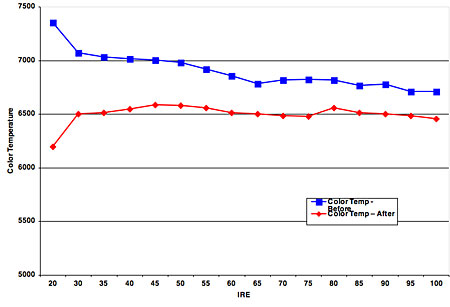
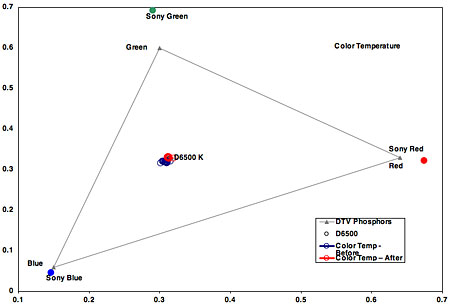
Full-On/Full-Off Contrast Ratio—6776:1;
ANSI Contrast Ratio—294:1
Measured Resolution with the Leader LT-446:
480: 480 (per picture height)
720p: 720 (pph)
1080i: 1040 (pph)
DC Restoration (poor, average, good, excellent): Excellent
Color Decoder (poor, average, good, excellent): Excellent
Measured Color Points:
Red Color Point: x=0.674, y=0.323
Green Color Point: x=0.290, y=0.692
Blue Color Point: x=0.146, y=0.046
The left chart shows the KDS-R50XBR1's gray scale relative to its color temperature at various levels of intensity, or brightness (20 IRE is dark gray; 100 IRE is bright white). The gray scale as set by the factory, in the warm color-temperature mode and the Pro picture mode, measures cool with dark images and warmer, but still cool, with brighter images. After making adjustments using the Photo Research PR-650, the gray scale measures within 84 Kelvin of D6500, the accurate color temperature, across most of the range. The darkest images are slightly warm.
The right chart shows the gray scale (or color temperature) relative to the color points of the display's red, green, and blue LCOS panels. These are off those specified by SMPTE. Red is oversaturated, while blue is slightly oversaturated. Green is very oversaturated.
After calibration, and using a full-field 100-IRE white (142.3 foot-lamberts) and a full-field 0-IRE black (0.021 ft-L), the contrast ratio was 6,776:1. Using a 16-box checkerboard pattern (ANSI contrast), the contrast ratio was 294:1. The best contrast ratio was achieved with the iris set at 4 and the Advanced Iris set to Max. The best black level was achieved with the iris set to 2 (or below), the Advanced Iris set to Max, and the power consumption set to Reduced. In this mode, it produced 0.017 ft-L and 113.2 ft-L for a contrast ratio of 6,659:1.—GM






























































